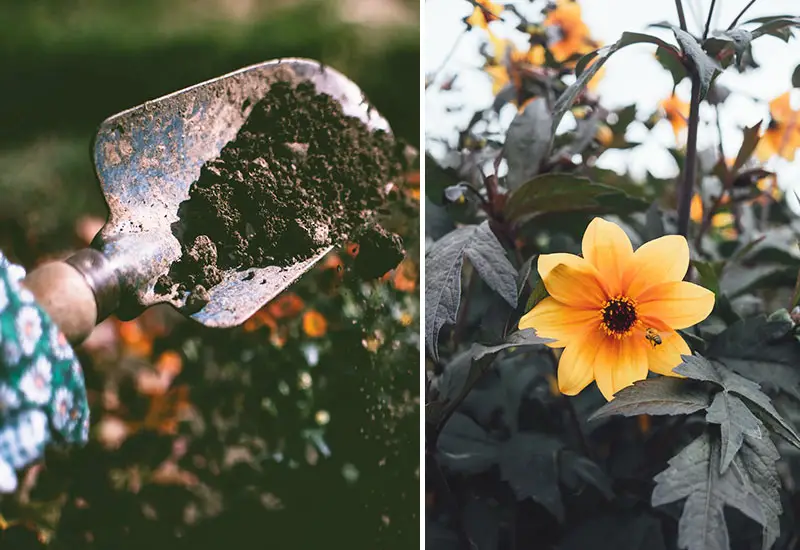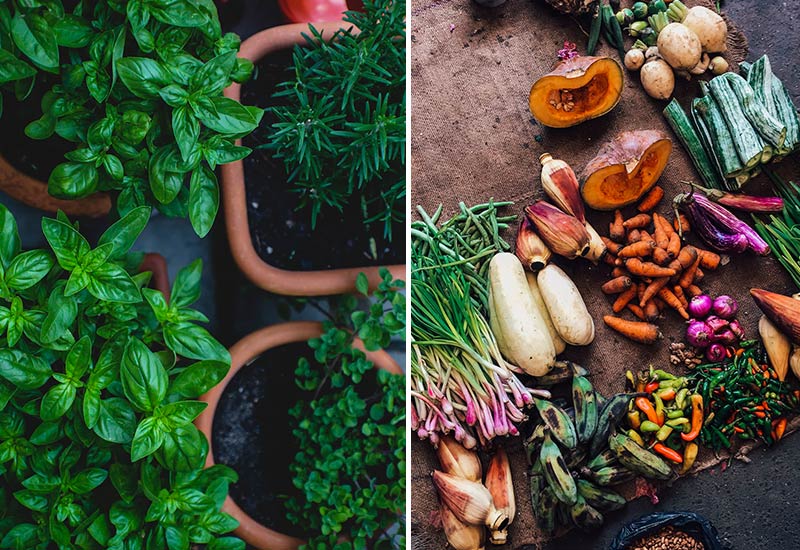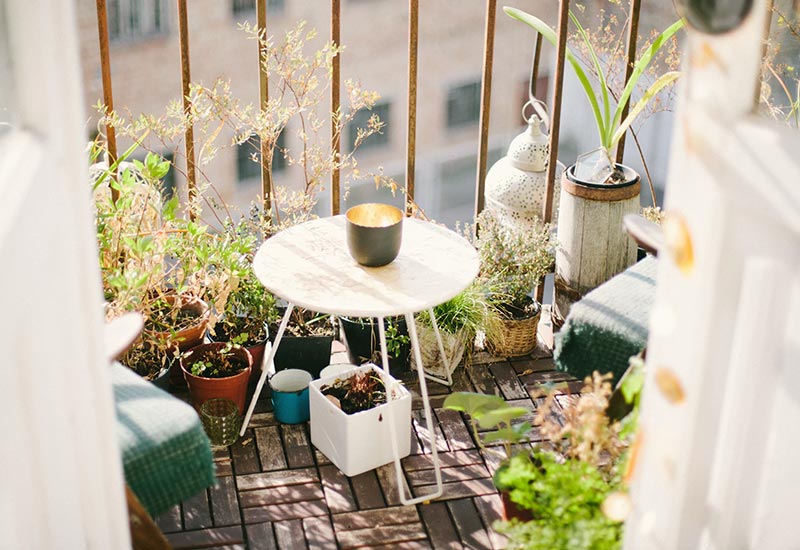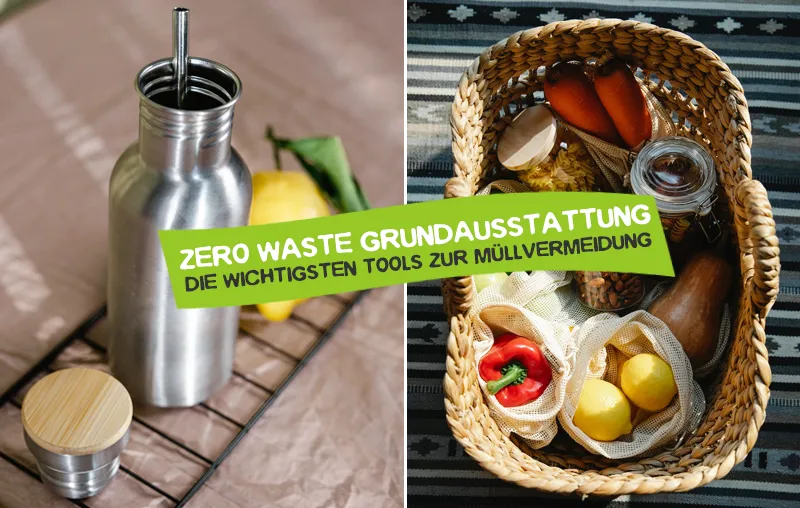You want to make your balcony sustainable? Then you've come to the right place! Around 59 million Germans own a Terrace or a balcony.₁ But often the latter is used quite umemotionally only as a kind of storage space. Others, after all, regard it as an additional living space with a few plants that offers relaxation - in the village, but especially in the city.
But "Balcony" can do so much more! If you too have a balcony, you can transform it into a vibrant paradise of well-being with just a few small, resource-saving measures that provide food for animals, produce fertile soil, supply fresh food, and make your ecological footprint massively improved.
In this article I would like to show you now how exactly you can make your balcony garden environmentally friendly and sustainable. Use the following 10 tips to create a little piece of nature between heaven and earth. Because your balcony - big or small - can be just that. You just have to let it be. Let's go!
1. use potting soil without peat

A green balcony needs the right soil. Unfortunately, however, the peat in the bags of garden soil often available in DIY and plant markets these days comes from raised bogs. Its extraction contributes to the Species Extinction with, the intact moor landscapes drained and habitats of countless animal and plant species destroyed.
Since the world's peatlands are about twice as much CO2 stored have as all forests combined, potting soil with peat also drives the Climate Change ahead.
As Substitute for peaty soil serves for example peat-free soil from the construction and plant market. But of course also the self-applied Compost, sands, coffee grounds or Softwood mulch are more environmentally friendly alternatives for your plants in your balcony garden.
2. select bee friendly plants
Balcony plants are much more than just a visual highlight! Especially insect-friendly plants promote the Biodiversity and help our buzzing friends find food. NABU recommends paying particular attention to native perennial hardy plants, like small Woody plants and perennials or climbers at set - also, as they survive the winter on "balconies".₂
The attracted Wild bees, butterflies and countless other insects in turn attract more and more birds, so that your balcony garden becomes really lively. They also help themselves from time to time to the Snack fruit, that on a pet and environmentally friendly balcony is always welcome.
Here are some insect or bee friendly balcony plants you should definitely get.
Plants for garden balconies with a lot of sun:
- Checkerboard flower
- Blue Mint
- Soft woman mantle
- Rosemary
- Wood Vine
- Blackberry
- …
Plants for garden balconies rather in the shade / partial shade:
- Caucasian chamomile
- Forest forget-me-not
- Evergreen honeysuckle
- Raspberry
- Red currant
- …
Easy to maintain and at the same time extremely effective are also wild buckets - so plant pots in which you sprout low-maintenance wildflowers.
Tip: The aforementioned plants on your balcony will help decisively to Promote biodiversity. What else you can do, especially to Stop insect mortalityI'll be happy to explain this to you in the linked blog articles.
3. get the right pots, boxes and tubs.
You should also look carefully when choosing the containers for your balcony plants. Sustainable balcony boxes and pots, for example made from recycled plastic or natural clay, are durable and environmentally friendly.
In general, your pots, boxes and tubs should be be stable and frost-resistant and have sufficient volume provide for the roots of the plants. It is also important that the water through a Hole at the bottom and some expanded clay can drain off to prevent waterlogging.
Fortunately, as you can see, with the right containers, you can even without own garden Sustainable gardening. So nothing stands in the way of your green balcony!
Tip: Raised beds also serve as containers for your plants. You can design them completely individually and, for example, build them yourself inexpensively from old Euro pallets.
4. install balcony power plant with storage
Solar collectors on the balcony railing can reduce the Capture sunlight and convert the solar energy into usable alternating current via the generator. With the help of a corresponding Balcony power plant with storage you can also store electrical energy and conveniently call it up when you need it. And if you want, it can also be fed into the public grid.
Such a power plant makes your balcony not only more sustainablebut also helps you save electricity and energy costs. In addition, it is simply attached to the balcony railing, so it basically does not even take up space.
Tip: Try to keep the lighting on your balcony as low as possible and only turn it on when you really need it. In this way, you can protect post-active insects, which could otherwise be attracted to artificial lighting and die. If you do not want to do without light, then in any case prefer targeted LED lights with the lowest possible ultraviolet and blue content.
5. grow herbs, fruits and vegetables

With a raised bed on the balcony, where you grow your favorite fruits and vegetables, you can wonderfully provide for yourself. But it is important to always take into account, how much sun, shade and humidity need the respective plants.
Whether in a planting bag, in a tub or in a raised bed - here are some Foods that experience has shown are very suitable for growing in the balcony garden.
- Paprika
- Chard
- Beans
- Eggplants
- Tomatoes
- Salad
- Cucumbers
- Zucchini
- Kohlrabi
- Potatoes
- Blueberries
- Apples
- Pears
- Strawberries
- Parsley
- Rosemary
- Thyme
- Oregano
- Basil
- …
Tip: Sometimes so-called "pests" affect the harvest. For high crop yield and as little animal suffering and environmental damage as possible, you should then definitely go to the natural pest control (e.g. thyme against the cabbage white caterpillar). And to promote the growth of your plants, organic fertilizers (such as coffee grounds) are advisable.
6. provide watering trough, sand bath and nesting boxes for birds.
The food supply in your balcony garden is now very diverse. What is still missing for the feathered friends of balcony owners is a drinking trough, a sand bath and a nesting box for shelter. So provide a shallow bowl with water and sand, so that the animals can absorb enough liquid and clean yourself at any time can.
With a nesting box you offer them a safe dwelling - especially in spring, when, for example, house sparrows or coal and blue tits raise their offspring. For more inspiration and lots of ideas for your sustainable balcony, you can also read the blog article about the Bird friendly garden pick up
Tip: Speaking of nesting boxes! Bees and other insects can of course also be offered a suitable dwelling with a (self-built) bee hotel.
7. recycle biowaste in worm composter or bokashi bucket.
Special worm composters and bokashi buckets do not actually stink. Nevertheless, it can make sense to place them outside in the fresh air on the balcony. Especially when the Balcony near the kitchen located.
Either way, this way you can turn biological waste into fertile soil respectively valuable fertilizer and use it directly again for your balcony plants.
8. prefer fair and ecological balcony furniture
Unfortunately, balcony furniture is not automatically sustainable just because it is made of wood. The material could be for example from the rainforest or generally from illegal timber trade originate
You can recognize furniture from sustainable forestry, for example, by the widespread FSC seal or the even more stringent criteria subject Naturland seal. Even better is to avoid buying new altogether. This works by buying tables or chairs for the balcony used (eg, through classified ads) or build them yourself from old wooden planks. The more durable and resource-saving, the better.
9. collect rainwater from the gutter
Instead of using tap water for balcony garden irrigation, you can simply use lime-free rainwater in a Barrel, a canister or a bucket collect.
Here are some ways to capture rainwater on your balcony:
- Rainwater flap: Maybe you have a rain gutter or downspout on your balcony, so you can use what's called a rain strainer to divert and collect water into a catch basin.
- Inverted canister: Many of us have a covered balcony. Nevertheless, for example, with a 5-liter canister turned upside down and attached to the balcony railing, from which you have previously cut off the bottom, you can collect rainwater and direct it into a container.
- Stretched tarpaulin: Those who do not have a roof over the balcony, should take advantage of it even more! Simply attach a tarp and weigh it down in the middle so that the water runs directly to the hole in the middle, from which the rainwater flows into the container below. Alternatively, it works with a tarp attached to a clothes rack with clothespins. It is important that the collected water always drains to a certain lower point.
10. balcony decoration build yourself, upcycle or buy used

Homemade decorations, as well as upcycling and DIY projects will give your balcony a creative, personal touch, reduce waste and conserve natural resources of everyday life.
For example, convert a old wine barrel into a rainwater tank with tap and/or bar table. Many things like old canisters or beverage and egg cartons, can also be used wonderfully as a flower pot alternative. There are no limits to creativity when it comes to making the balcony as environmentally conscious and sustainable as possible.
Environmentally friendly and sustainable balcony, made easy!
As you can see, can be a balcony the garden, for those who do not have a garden. With the means and measures mentioned above, you can transform it in no time into a mecca of biodiversity, a near-natural paradise for birds and insects, and a floating temple of well-being.
"Adopt the pace of nature: her secret is patience."
Ralph Waldo Emerson (more at Environmental protection quotes)
If you really feel like having a green, vibrant balcony where you can enjoy the hustle and bustle of the bees and the chirping of the birds during the well-deserved coffee break then simply implement the ideas and advice from this article step by step. Please keep in mind at all times that a sustainable balcony doesn't have to be a quick fix. Rather, think of it as a continuous process that you master step by step.
Do you have any questions, suggestions or would you like to share your own experiences with environmentally friendly balcony design? Then I'm really looking forward to your comment!
Stay sustainable,

PS: I have another tip for a more environmentally friendly balcony or garden -. make your windows bird proof! How exactly you prevent birds from flying against the reflective windows, I show you now in the linked blog article.
References:
₁ VuMA; IFAK (2022): Number of people in Germany who own a balcony or terrace from 2018 to 2021, available at https://de.statista.com/statistik/daten/studie/172077/umfrage/besitz-von-balkon-oder-terrasse. [14.08.2023].
₂ NABU (Naturschutzbund Deutschland) e. V.: Video-Tipp - Start in die Balkonsaison So wird der Balkon eine Oase für Mensch, Vögel und Insekten, abrufbar unter https://www.nabu.de/umwelt-und-ressourcen/oekologisch-leben/balkon-und-garten/trends-service/diy-rezepte/31567.html. [14.08.2023].




